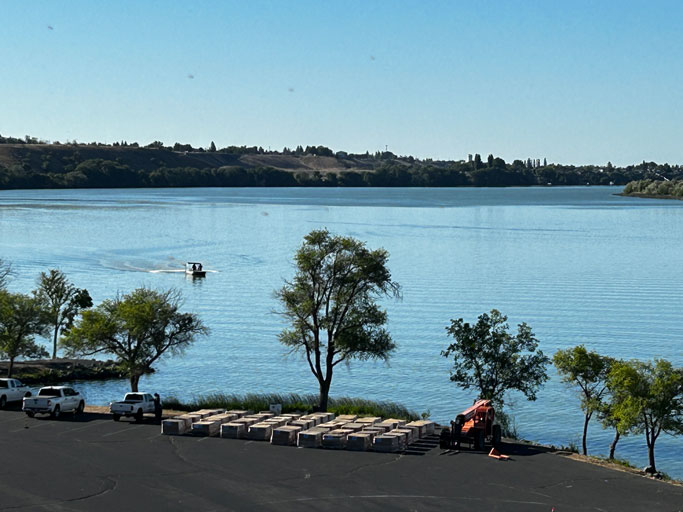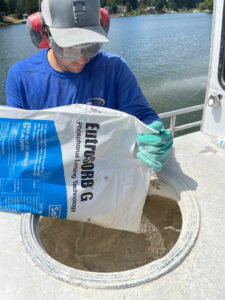
Clay mixture could help prevent algal blooms in Moses Lake
Listen
(Runtime 1:08)
Read
In 2018 and 2019, toxic algae blossomed at the end of June, closing all of Moses Lake. Now, volunteers for Grant County Healthy Lakes Blue-Green Algae Tracker monitor the lake each week so the lake doesn’t close when there’s an algal bloom.
The timing of the toxic bloom can drastically impact the local economy, said Ron Sawyer, chairman of the Moses Lake Watershed Council.
“That can have a dramatic effect on our Fourth of July and all of the shoulders around Fourth of July, which are very important to our economy,” Sawyer said. “If the bloom happens later in the year, even if it’s toward Labor Day, it doesn’t have as big of an effect on the community.”
Grant County, where the lake is located in central Washington, is a top place for people to fish in the state. The lake also supports over 1,200 jobs and 40 businesses in the area, according to the watershed council.
The algal blooms can also be toxic to people and pets. Notably, several dogs died after swimming in toxic waters, including the Columbia River last year.
That’s why the watershed council began searching for solutions. They quickly were pitched a way to sequester the phosphorus that helps cause these blooms, which would mean the blooms have a smaller chance to occur.
Unfortunately, they didn’t have the money.
Then, U.S. Rep. Dan Newhouse, R-Washington, included the proposed project in a funding package. The first year of the project will cost $3.1 million. Next year, officials are requesting $5 million to treat more of the lake. Eventually, it could cost at least $25 million over multiple years, Sawyer said.

Crews mix the material lanthanum with clay. It then binds to phosphorus to sequester it deep in the lake. Phosphorus is a main driver of harmful algal blooms in Moses Lake. (Credit: EutroPHIX)
“We need to do a lot more work here. Once we fully address the phosphorus load, then we would expect the results to last for 10 or 20, potentially even 30 years,” said Scott Shuler, the director of technology and operations at EutroPHIX, a task force that treats harmful algal blooms across the U.S.
EutroPHIX is applying its technology to the Rocky Ford arm, in the northern area of the Moses Lake, where the worst blooms occur. The treatments will continue through June 12.
“The most prevalent place, and the earliest blooms usually occur, is around Blue Heron Park or Connelly Park. Both of those are in the area of the lake known as the Rocky Ford arm,” Sawyer said.
The biggest contributor of phosphorus is the legacy sediments from the last 50 to 100 years, where the phosphorus comes from natural erosion of thousands of years and from towns and cities.
“We’ve accelerated that process with our stormwater drainage,” Shuler said. “You have agriculture, those fertilized fields increase the load coming into lakes, as well as urban lawns. So, the sources are plentiful.”
Phosphorus also flows in from Rocky Fork Creek.
“This phosphorus is highly, highly soluble and is very available to grow algae through the summer. It’s a phosphorus source that the algae like to use to grow,” said Ryan Van Goethem, limnologist and project lead with EutroPHIX.
EutroPHIX is using a lanthanum material mixed with clay to sequester the phosphorus so that it can’t help harmful algae grow.
“Once it’s bound, it forms an insoluble mineral that just sinks down into the lake sediment and over time just sinks deeper and deeper,” Shuler said.
It’s also safe for fish, according to the company, like the regular algae they eat. Sawyer noted people might sometimes see algae in Moses Lake, but it’s not always the bad kind.
“Moses Lake is always going to have a green tint to it. It’s never going to be clear, because there’s a lot of beneficial algae that is the food source for all the fish and animals that use the lake. The part of it that becomes toxic is the cyanobacteria,” Sawyer said. “It’ll look like there’s green paint scum on the water, or sometimes it turns brown and kind of reddish.”
A quick way to tell the difference, he said, is to scoop up a plastic bottle of water and leave it in the fridge overnight. If the algae floats, it’s the bad kind.
On Moses Lake, the harmful blue-green algae produces the toxin microcystin, Sawyer said.
Harmful algal blooms occur across the U.S., and scientists expect them to get worse and more frequent as the climate continues to change.
The U.S Centers for Disease Control and Florida Gulf Coast University recently studied the phenomenon of harmful algal blooms becoming aerosolized.
“They’ve found that 100% of the people that have come off the lake in this study have these toxins in the respiratory system. So, this is another route of exposure that’s concerning,” Shuler said.
The biggest concern, he said, is chronic exposure to these toxins.
In the Northwest, EutoPHIX has treated lakes across Washington, including Long Lake in Thurston County, Shelly Lake in Spokane Valley and Lacamas Lake near Vancouver, Washington.















